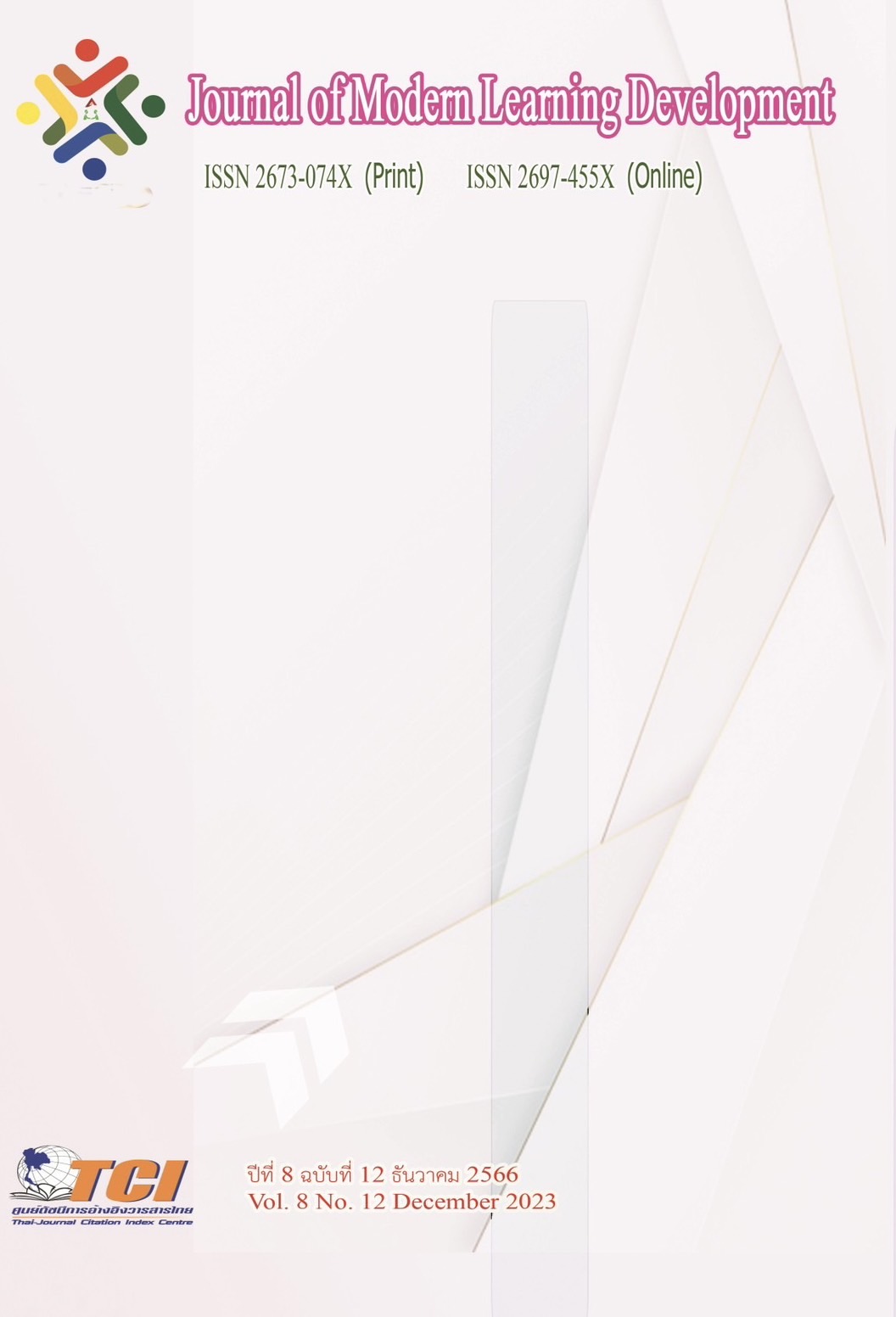The Effect of Using Collaborative Strategic Reading for English Reading Comprehension Ability of Mattayomsuksa 5 Students, Bodindecha (Sing Singhaseni 2 School)
Main Article Content
Abstract
This quasi-experimental research aimed to 1) compare student’s English reading comprehension ability before and after learning with the collaborative strategic reading and 2) compare student’s English reading comprehension ability of the experimental group taught by collaborative strategic reading and the controlled group taught by conventional instruction. The simple random sampling was employed in this research and the participants were seventy-four Mattayomsuksa 5 students studying in the 2nd semester academic year 2022 at Bodindecha (Sing Singhaseni) 2 School.
The research instruments included the collaborative strategic reading lesson plans, traditional learning approach lesson plans and the English reading comprehension test. The data were analyzed by mean (M), standard deviation (S.D) and T-test for the dependent samples and the independent samples.
The findings showed that
1. The experimental group’s English reading comprehension ability from the post-test result was significantly higher than the pre-test result at the .05 level.
2. The experimental group’s English reading comprehension ability from the post-test result was significantly higher than the controlled group’s reading comprehension ability at the .05 level.
Article Details
References
กรรณิกา คณานันท์. (2551) การพัฒนาความเข้าใจในการอ่านภาษาอังกฤษ ทักษะการคิดวิเคราะห์ และความ พึงพอใจต่อการเรียน โดยใช้รูปแบบการเรียนแบบร่วมมือ เทคนิค CIRC ร่วมกับผังกราฟิกของ นักเรียน ชั้นมัธยมศึกษาปีที่ 2. วิทยานิพนธ์ปริญญาศึกษาศาสตรมหาบัณฑิต. สาขาวิชาการวิจัย พัฒนาการศึกษา. บัณฑิตวิทยาลัย: มหาวิทยาลัยราชภัฎสกลนคร.
กระทรวงศึกษาธิการ. (2553). หลักสูตรแกนกลางการศึกษาขั้นพื้นฐาน พุทธศักราช 2551. (พิมพ์ครั้งที่ 3). กรุงเทพมหานคร: โรงพิมพ์ชุมนุมสหกรณ์การเกษตรแห่งประเทศไทย.
คณะกรรมการการศึกษาขั้นพื้นฐาน. (2564). นโยบายและจุดเน้นของคณะกรรมการการศึกษาขั้นพื้นฐาน ประจำปีงบประมาณ 2566. ออนไลน์. สืบค้นเมื่อ 25 พฤศจิกายน 2565. แหล่งที่มา https://www.obec.go.th/about
จิราภา อ่ำแจ้ง และ วิสาข์ จัติวัตร์. (2563). การพัฒนารูปแบบการสอนอ่านเน้นภาระงานโดยใช้กลวิธีการอ่าน แบบร่วมมือเพื่อเสริมสร้างความสามารถในการอ่านเพื่อความเข้าใจ กลวิธีการอ่านแบบร่วมมือและ ทักษะการคิดวิเคราะห์สำหรับนักเรียนชั้นมัธยมศึกษาปีที่ 3. วารสารร้อยแก่นสาร, 6(6), 1-19
ธีราภรณ์ กิจจารักษ์. (2553). ปัจจัยที่ส่งผลต่อการพูดภาษาอังกฤษของนักศึกษาชั้นปีที่ 2 สาชาวิชา ภาษาอังกฤษ คณะครุศาสตร์. ออนไลน์. สืบค้นเมื่อ 17 ธันวาคม 2565 แหล่งที่มา http://ssruir.ssru.ac.th/handle/ssruir/874?mode=full
นวภัทร สมานพันธ์. (2555). การพัฒนากิจกรรมการเรียนรู้โดยใช้กลวิธีการอ่านแบบร่วมมือและเพลงเพื่อ พัฒนาผลสัมฤทธิ์ทางการเรียน กลุ่มสาระการเรียนรู้ ภาษาไทยของนักเรียนชั้นประถมศึกษาปีที่3. วิทยานิพนธ์ศึกษาศาสตรมหาบัณฑิต. สาขาวิชาหลักสูตรและการสอน. บัณฑิตวิยาลัย: มหาวิทยาลัยขอนแก่น.
มณชนก มโนราช. (2563). การใช้กลวิธีการอ่านแบบร่วมมือเพื่อการพัฒนาความสามารถในการอ่านจับ ใจความภาษาอังกฤษ ในรายวิชาการอ่านสื่อสิ่งพิมพ์ภาษาอังกฤษสำหรับนักศึกษาระดับ ประกาศนียบัตรวิชาชีพ ชั้นปีที่ 2 สาขา สถาปัตยกรรมวิทยาลัยเทคโนโลยีเมโทร ปีการศึกษา 2563. รายงานการวิจัย. วิทยาลัยเทคโนโลยีเมโทร
วราภรณ์ พรมอินทร์. (2561). การพัฒนาความสามารถในการอ่านภาษาอังกฤษเพื่อความเข้าใจของนักเรียน ชั้นมัธยมศึกษาปีที่ 5 โดยใช้กลวิธีการอ่านแบบร่วมมือ. วิทยานิพนธ์การศึกษามหาบัณฑิต. บัณฑิต วิทยาลัย: มหาวิทยาลัยบูรพา.
วิชญะ น้อยมาลา. (2564). ทักษะจำเป็นของการทำงานในศตวรรษที่ 21. ออนไลน์. วารสารวิชาการรัตนบุศย์ (RATANABUTH JOURNAL), 3(1), 45-57. สืบค้นเมื่อ 25 พฤศจิกายน 2565, แหล่งที่มา https://so07.tci-thaijo.org/index.php/rtnb/article/download/595/450/2055
สำนักบริหารงานการมัธยมศึกษาตอนปลาย สำนักงานคณะกรรมการศึกษาขั้นพื้นฐาน. (2559). แนวทาง จัดการเรียนรู้ในศตวรรษที่ 21 “21st Century Skill”. ออนไลน์. สืบค้นเมื่อ 27 มีนาคม 2566 แหล่งที่มา https://webs.rmutl.ac.th/assets/upload/files/2016/09/20160908101755_51855.pdf
สุคนธ์ สินธพานนท์และจินตนา วีรเกียรติสุนทร. (2556). การจัดการเรียนรู้ของครูยุคใหม่สู่ประชาคม อาเซียน. (พิมพ์ครั้งที่ 1). กรุงเทพมหานคร : จุฬาลงกรณ์มหาวิทยาลัย.
Farnaz Masoud Kabir and Ghasem Aghajanzadeh Kiasi. (2018). The Effective of Collaborative Strategic Reading on EFL Learner’s Reading Comprehension and Vocabulary Knowledge. European Journal of Foreign Language Teaching, 3(1), 1-16.
Johnson, R.T. & Johnson, D.W. (1994). An Overview of Cooperative Learning. In J.S. Thousand, R.A. Villa &A.I. Nevin (Ed.). Creativity and Collaborative Learning.
-34. (1st ed.). Baltimore, Maryland: Paul H. Brookes Publishing.
Klingner, J. K., Vaughn, S., & Schumm, J. S. (1998). Collaborative Strategic Reading. During Social studies in heterogeneous fourth-grade classroom. Elementary School Journal, 99, 3-21.
Sofyan A. Gani, Yunisrina Qismullah Yusuf, Rini Susiani. (2015). Progressive outcomes of collaborative strategic reading to EFL learners. Kasetsart Journal of Social Sciences, 37, 144-149.


